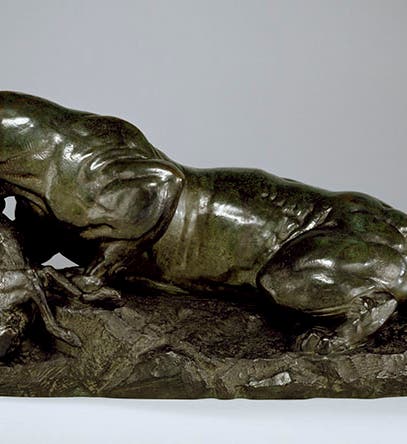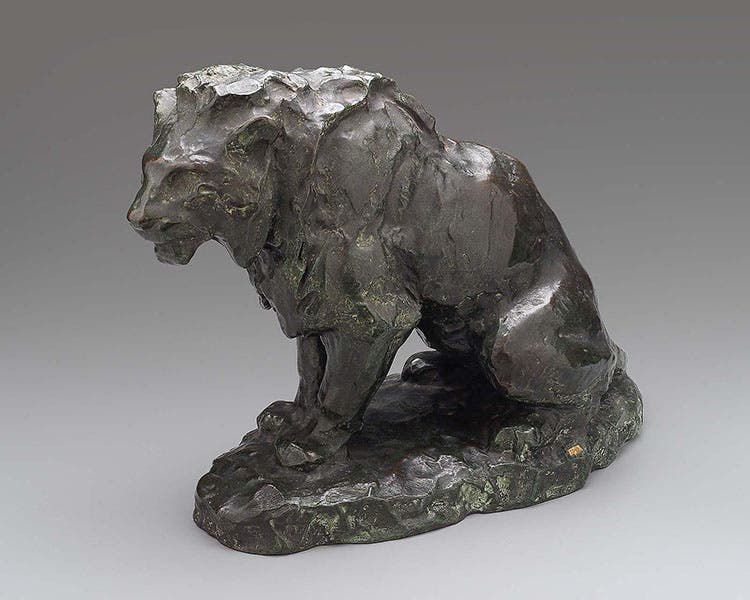Scientist of the Day - Ferdinand Barbedienne
Ferdinand Barbedienne, a French fondeur (foundry operator) was born Jan. 10, 1810. Barbedienne ran one of the premiere bronze foundries in Paris in the mid-to-late 19th century, first with Achille Collas, and then, after Collas died in 1859, on his own. Collas had invented, around 1838, a pantograph that allowed one to reduce three-dimensional sculptures in size, so that one could produce table-top versions of large standing sculptures, and this proved both useful and lucrative. So the foundry did well.
In Barbedienne's day, the foremost animal sculptor, or animalier, was Antoine-Louis Barye, who did extremely life-like bronzes of animals in combat, such as a crocodile catching an antelope, or a python attacking a tiger. We wrote a post on Barye seven years ago, where you can see some of his sculptures, which he used to cast himself.
Barye, due to financial problems, was forced to sell many of his casting models. After his death in 1875, over 100 of these were acquired by Barbedienne, and he proceeded to issue Barye bronzes until his own death in 1892 (with his son continuing the tradition after his death). Since Barye was a pre-eminent sculptor, and Barbedienne by all accounts ran the best bronze foundry in Paris, the partially posthumous marriage produced some exquisite bronzes. Our first image shows a Jaguar Devouring a Hare, which was cast by Barbedienne in 1882, and is now in the Walters Art Museum in Baltimore. You can tell at a glance that Barbedienne castings have exceptional finish, much better than the earlier versions that Barye cast himself.
The Nelson-Atkins Museum here in Kansas City has another Barye/Barbdienne bronze, this one called Tiger attacking a Peacock (it is actually the same animal that the Walters calls a jaguar – I am not sure who names these things.) The provenance line in the museum’s description says: “Cast by Barbedienne Foundry, Paris, after 1876,” and if there is documentary evidence for this, so be it, but to me it looks more like a Barye cast, since it lacks the superb finish of most of Barbedienne’s casts. As a further example, the National Gallery of Art has another copy of Jaguar Devouring a Hare, this one cast by Barye and obtained directly from the artist in 1874. You can see it at this link. Compare the finish of this sculpture with that in our first image, the copy in the Walters Art Museum, and see what you think.
Our third example I include because it is so unusual, at least to me. We all know that artists make preliminary sketches for their paintings, and many of these are preserved, but we don’t often think of a sculptor making a three-dimensional “sketch” for a sculptural project. But Barye did so, for a lion that he was sculpting for the Louvre. It is wonderfully charming and full of promise; I do not know what possessed Barbedienne to cast it, but we are happy he did. This example is in the Museum of Fine Arts in Boston (fourth image).
Our last example is my favorite, called variously African Elephant Running or Senegalese Elephant by different owners, although I prefer Prancing Elephant. It is a wonderful piece, exquisitely finished, and a credit to both Barye and Barbedienne. The example in the Walters Art Museum, which we show here, is only 7 inches long (fifth image). I do not know whether Barbedienne reduced it in size from a larger Barye original, or whether Barye made it small to begin with. Either way, it is a credit and an inspiration to elephants everywhere.
Barbedienne became renowned in the early stages of La Belle Époque, achieving a fame that quite eclipsed that of poor Barye. When he died in 1892, he was given an elaborate funeral and buried in Père Lachaise cemetery, under a tomb monument that is far from modest (sixth image). It is topped by a portrait bust by Henri Chapu, but we prefer the simpler portrait sketch by Thomas Couture that Sotheby’s offered up at auction in 2011 (second image).
William B. Ashworth, Jr., Consultant for the History of Science, Linda Hall Library and Associate Professor emeritus, Department of History, University of Missouri-Kansas City. Comments or corrections are welcome; please direct to ashworthw@umkc.edu.












